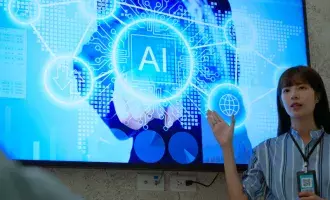Recent headlines around the concept of automation have sparked concerns that thousands of jobs will be lost as the ‘bots’ take over. However, far from replacing jobs, I’d argue that, overall, automation is helping people to deliver more value by giving them the opportunity to step away from the monotonous and time-consuming elements of their role.
Automation is the use of technology to perform tasks and processes without human intervention or with minimal human input. It involves using computer programs, algorithms, and machines to carry out repetitive, mundane, or complex tasks that would otherwise be performed by humans.
Automating processes gives people more time and capacity to focus on the autonomous and creative aspects of their work, which in turn boosts productivity. Whilst there’s still work to do for larger scale cultural adoption of automation, the benefits are being better understood by companies from the top down, which is paving the way for increased uptake of automation services that are being embedded into business operations.
In the public sector the issue of productivity is important because it’s a key factor for economic growth. In our recent report with The Productivity Institute - Making public sector productivity practical, we uncovered three drivers of productivity: adaptive business design, digital transformation and building an agile workforce. Automation sits squarely in the digital transformation camp, and we’re seeing many clients approach us for help with automation as their key enabler within their digital transformation strategy; using technology to simplify, streamline and enhance the delivery of their products and services so they can create better outcomes for their clients.
Automation has evolved significantly over the years. With the advent of advanced technologies such as artificial intelligence, machine learning and robotics, automation has become more intelligent, flexible, and capable than ever before. With these advanced technologies, the public roadmap is heading towards the need for intelligent automation solutions that can help businesses unlock more benefits. By combining the human element and cognitive thinking with the use of sophisticated algorithms and software applications, intelligent automation can learn, adapt, and perform tasks that were previously performed by humans.
Common areas where automation can be highly beneficial include:
- dealing with high volumes of common queries
- transcribing from speech to text
- handling high volume, repetitive processes that follow simple rules with limited judgement required
- computer vision, analysing various images and videos
- audio transcription
Automation helps people to become more human in their work
Automation can increase speed and accuracy, provide an audit trail, improve quality, compliance, and lean processing which in turn reduces training time. It can also provide important human benefits as well. For example, while a call handler in an insurance company is speaking to a customer on the phone, automation tools can quickly retrieve information about the customer’s last point of contact, or flag when their home insurance is due for renewal to help present an upsell opportunity. This means the call handler can focus on their conversation with the customer and does not have to waste time putting them on hold while they search for information. This provides better customer service and is also a more rewarding role for the employee, which increases job satisfaction and staff retention.
Automation in action
We have successfully helped a significant number of clients with their automation journey and demonstrated how automation can boost their productivity. For example, we helped one client in the finance and accounting industry reduce the time spent on manual processes, while another freed up several hours that employees could use to focus on more complex activities and queries. In health, we introduced intelligent automation to send out appointment reminders to patients which saved employee time while ensuring accuracy and auditability.
Taking a partnership approach to automation
We’ve invested to build a business solely focused on automation, and take a partnership approach, offering end-to-end automation-as-a-service capability from identifying opportunities for automation, developing the solution, and providing support. We use process mining, task mining and task capture to create a powerful toolset to help you analyse your business processes, identify areas for improvement, and automate tasks which can lead to increased efficiency, productivity, and cost savings, ultimately helping your business to achieve your goals more effectively. We play back the ‘as is’ and ‘to be’ process and recommend whether process re-engineering, automation, or a combination of these will deliver the most value based upon your business needs. We then continue to ensure your solutions are supported, with any issues quickly addressed and resolved.
Future of automation
Automation will significantly continue to transform the way we live and work. Who would have thought 15 years ago, we’d be able to order food, book flights and do our banking via our mobile phones without actually speaking to a human, or be able to talk into a piece of technology, such as Alexa, that could answer questions, dim your lights at home and even switch on your kettle.
The future of automation is full of possibilities. Where automation will increase the use of artificial intelligence (AI), enabling machines to perform intelligent and imaginative functions of a human, such as learning, reasoning, problem-solving, and decision-making within most industries and sectors. The types of skill sets required in the market will change to more advanced robotics, maintaining and updating automation systems.
Imagine airlines using advanced automation and AI to fly you to your destination with no need for pilots. Advanced sensors that identify weather conditions and any hazards, on the ground and in the air whilst identifying other aircrafts, to prevent any incidents. Airports using automation and AI for route mapping, air traffic control (ATC) with minimal or no human interaction.
Imagine having self-driving vehicles, where you can tell your car your destination and it will take you there, navigating through traffic and any hazardous conditions. We already use various forms of automation to order items online and instore, imagine the use of automation, with drones that deliver your items within a few hours. The possibilities are endless.
Any concerns that jobs will be lost will diminish as significant collaboration between humans and machines develops, working together to provide better outcomes.
Learn more about the different approaches you can take to boost productivity within your organisation:

Jiten Patel
Intelligent Automation Consultant, Capita
Jiten is an automation consultant at Capita within the Consult and Transform business. Working closely with clients he identifies and consults on areas of improvement by leveraging automation and AI capabilities to support client challenges and enable them to transform their business. Jiten’s background is in automation and service transition, delivering client automated solutions with minimal impact to a business.







